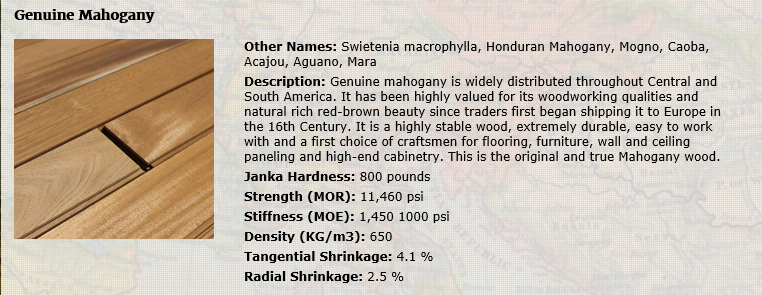Mahogany Decking - What's in a name?
By
Bill Christou,
02/06/17
When you have a cut on your finger, you stop the bleeding by reaching for a "Band-Aid" not a gauze bandage. When you need to blow your nose, you ask for "Kleenex" not tissue. If you are online and decide to look up something you "Google It" instead of searching for it.
When choosing a material for building a deck we often go by trade names that are not only no longer valid but are downright confusing. Within the building products industry, the term "Mahogany" decking is probably one of the worst culprits when it comes to misleading consumers.
Genuine Mahogany (Swietenia Macrophylla spp) is widely distributed throughout Central and South America. It has been highly valued for its woodworking qualities and natural rich red-brown beauty since traders first began shipping it to Europe in the 16th Century. Old growth Mahogany is a stable, durable wood specie used for flooring, furniture, wall and ceiling paneling and high-end cabinetry. This is the original and true Mahogany wood.
Today we primarily have only plantation-grown Mahogany available on the market. This product however is less-than-ideal for use as outdoor decking. The fiber is of a lower quality with large growth rings and is much easier to dent and prone to bend/break when force is applied. The plantation grown Mahogany also comes with questionable natural durability due to the inclusion of sapwood. The product also comes with very poor length tallies and is therefore far more suited to cabinetry or furniture making.

In fact, most Mahogany used for decking is not the genuine old-growth Mahogany (Swietenia Macrophylla) that most consider to be the real and true species when referring to Mahogany. Instead, the so-called "Mahogany" sold as decking today is one of a variety of species normally from Brazil, Malaysia or Indonesia.
Since most homeowners choose "Mahogany" decking for its perceived hardness, rich red color, tight grain, knot-free appearance and natural resistance to rot, we thought we would analyze and access the different products on the market today.
The three main species of decking currently marketed as Mahogany Decking are:
Batu / Red Balau (Shorea Guiso spp)
Batu / Red Balau is found throughout the Malay Peninsula, Indochina, Indonesia and the Philippines. The heartwood will usually range from a light to deep red brown with the sapwood being lighter in color and not always sharply demarcated. The texture of Batu is moderately fine to slightly coarse and the grain is typically interlocked. Batu is without a characteristic odor or taste and is easily identified by the presence if resin canals with white contents in concentric lines on end surfaces.
Cambara (Erisma Unicinatum spp)
Cambara is found throughout Central and South America from southern Mexico to Peru but most abundant in the Guianas and Brazil. The heartwood is a dull uniform pink, pinkish brown or golden brown and is not always sharply demarcated from the whitish to yellowish sapwood. The luster of Cambara is medium to high and the texture is moderately coarse. The grain pattern of Cambara is slightly to highly interlocked and the specie is without a distinctive odor or taste.
Philippine Mahogany / Meranti
(Major Species producing this timber include: S. Stenoptera, S. acuminata (partly), S. argentifolia, S. curtisii, S. ovata, S. monticola, S. pauciflora, S. platyclados and S. slootenii. spp)
Meranti naturally occurs in Malaysia, Indonesia, and the Philippines. The heartwood color is variable from almost white to pale pink to dark red, or pale brown to deep brown and the sapwood is lighter in color and usually has a grayish tinge. The grain is usually interlocked, however certain species of Meranti can also exhibit a somewhat straight grain. Meranti's texture is coarse with a slightly lustrous surface and usually without a characteristic odor or taste.
Over the years, clever marketing campaigns have pitched a variety of "Mahogany" species as true exterior hardwoods that stand up well to foot traffic and will endure the challenges outside for many, many years. Unfortunately the sad reality is that not all Mahogany is created equally and that most of the species sold as Mahogany are not well suited for long-term use outdoors.
While the three species all look similar, savvy consumers who are looking to add strength, lasting beauty, and long-term value to their home should educate themselves on the physical and mechanical properties associated with each species before making a final decision on which type of Mahogany to select!
To find out more or if you have any questions regarding this species, or any of our other products, please don't hesitate to
contact us.
By
Bill Christou,
02/06/17
Comments?
Display Name:
Contact Email:
please be respectful of others' opinions and do not use profanity.
comments may be edited for objectionable content.
Email addresses are not publicly posted, and are used to follow up directly with your comment as needed.




























